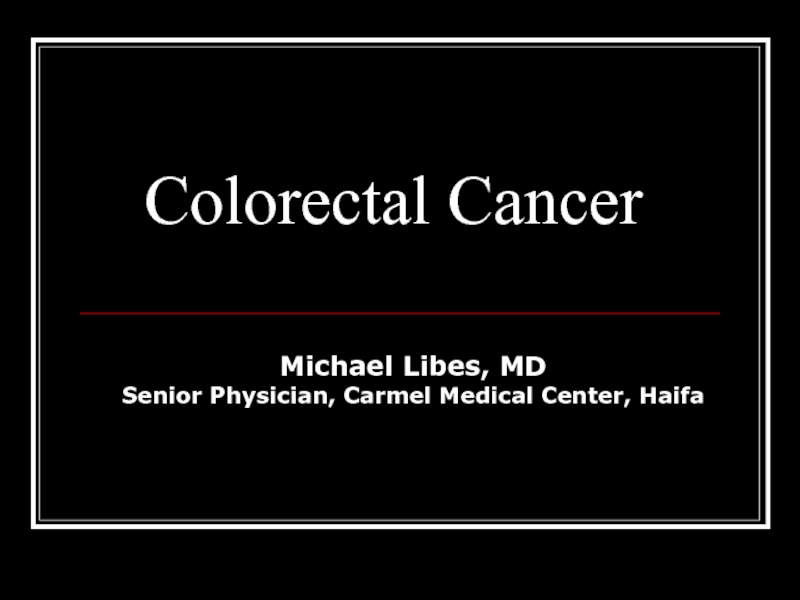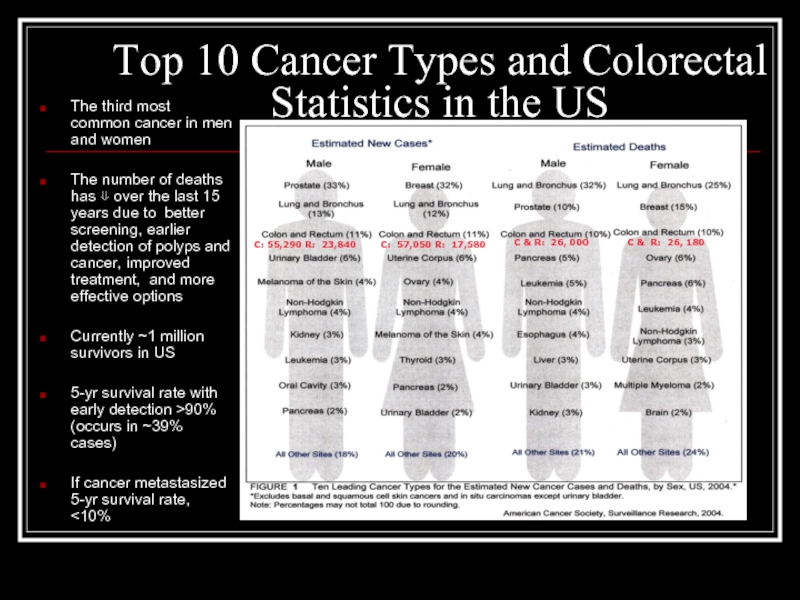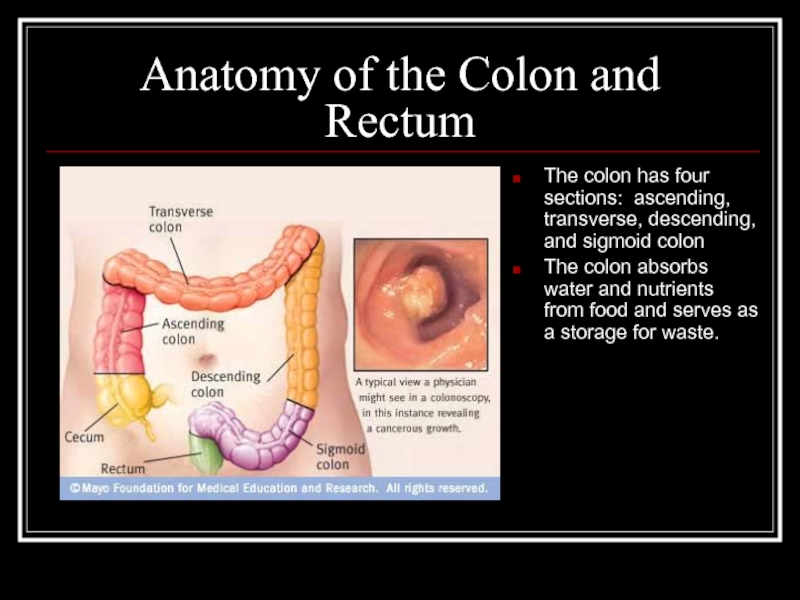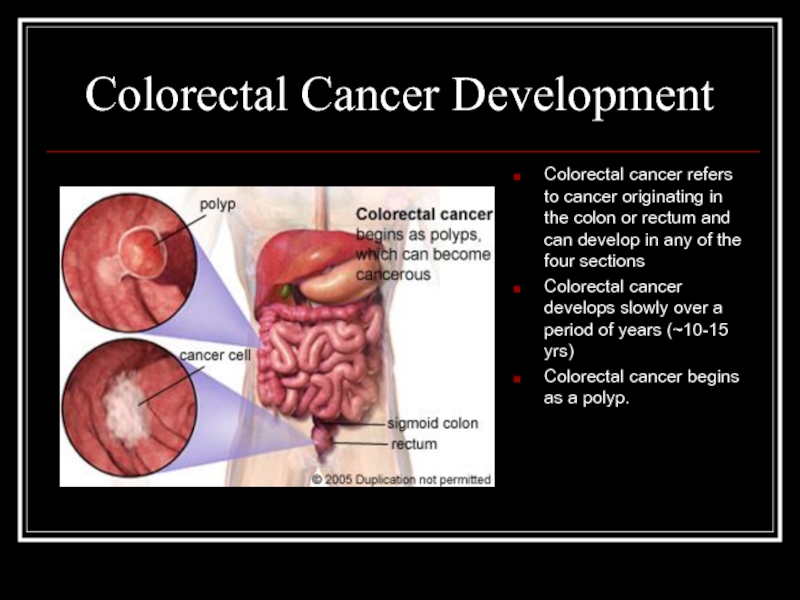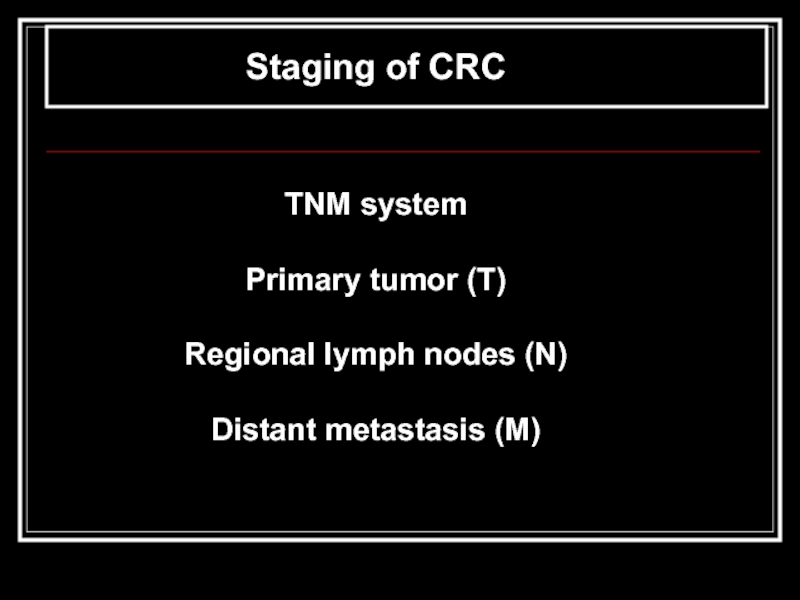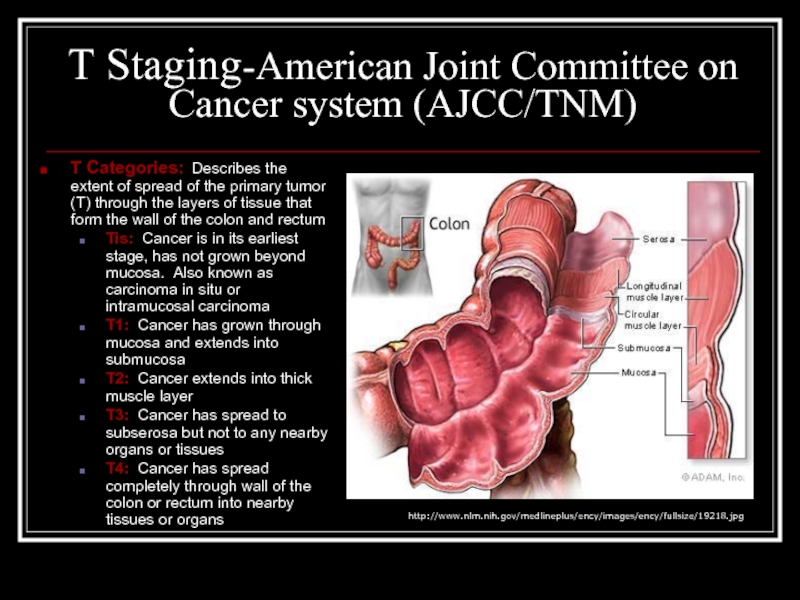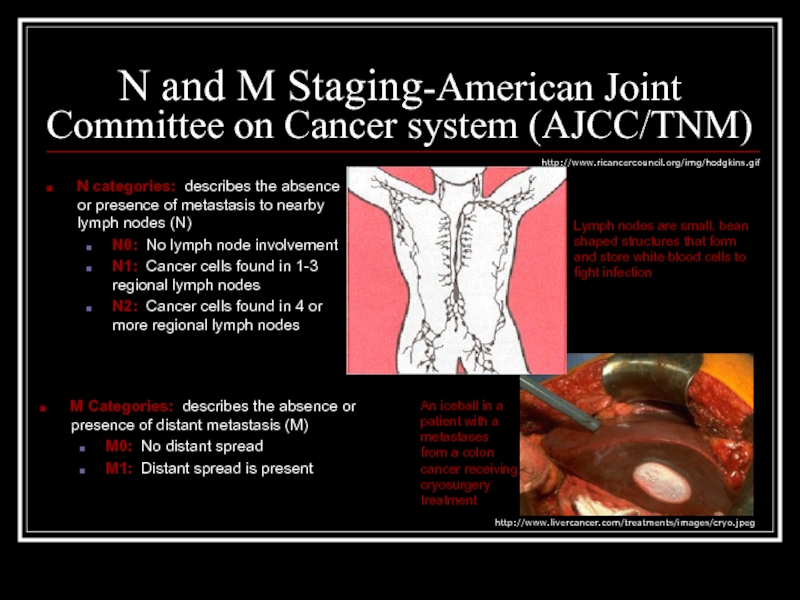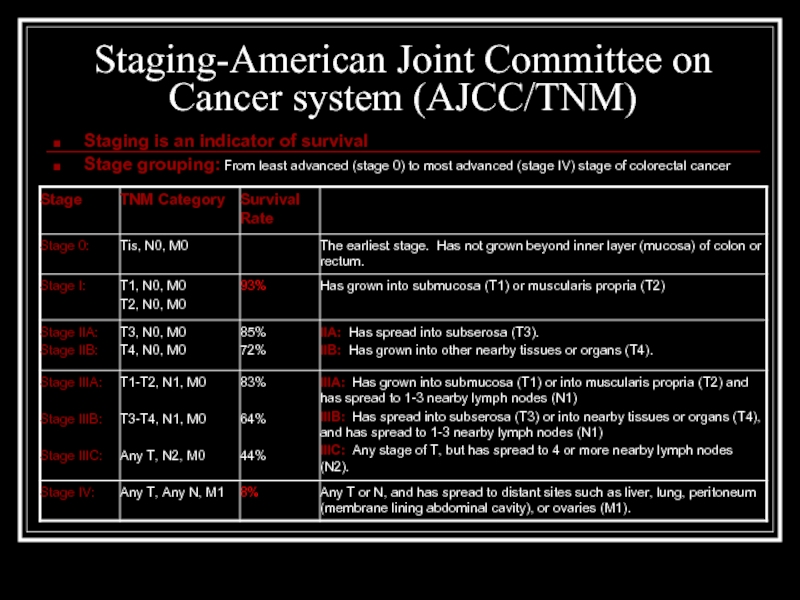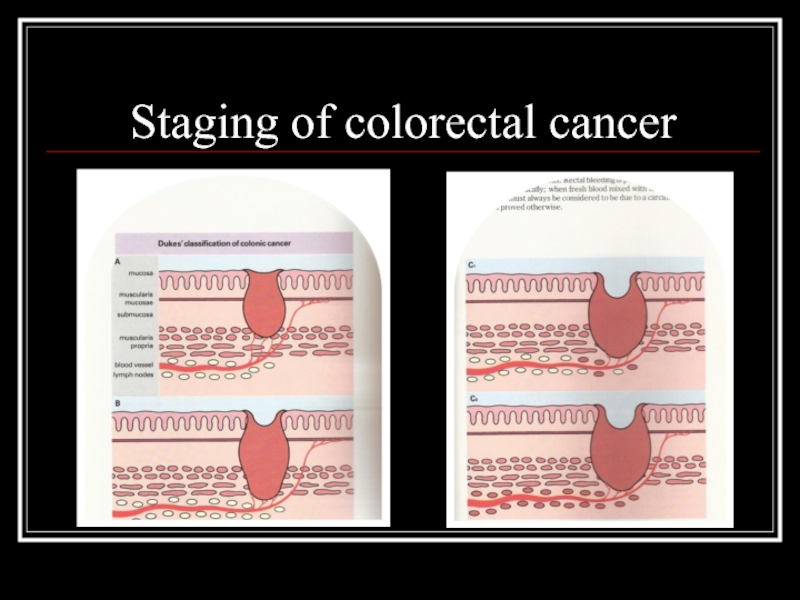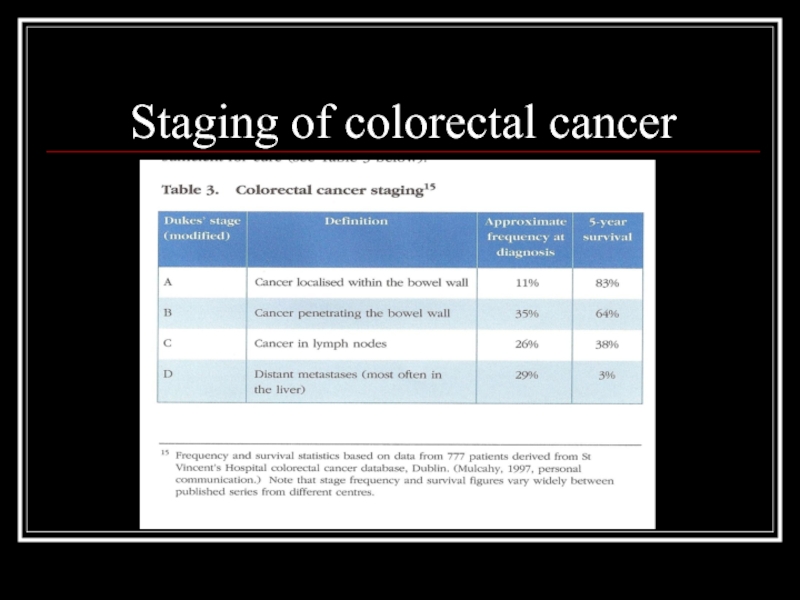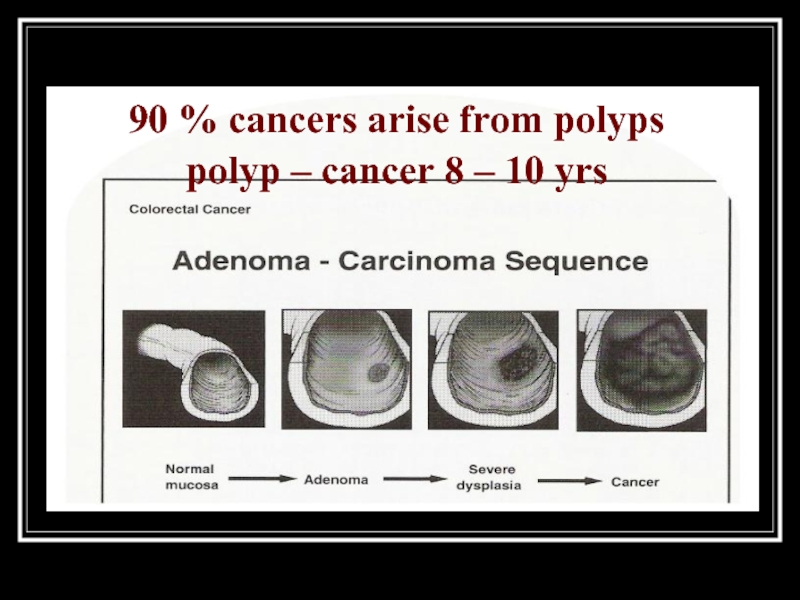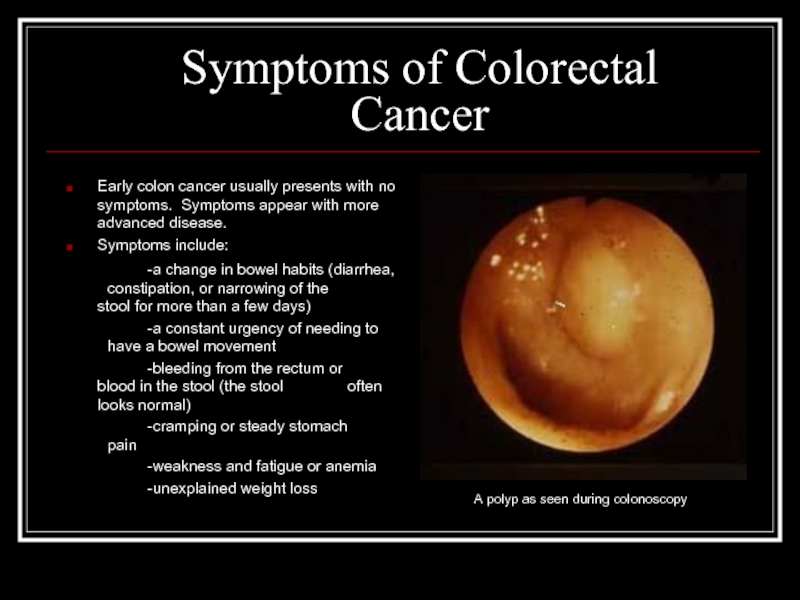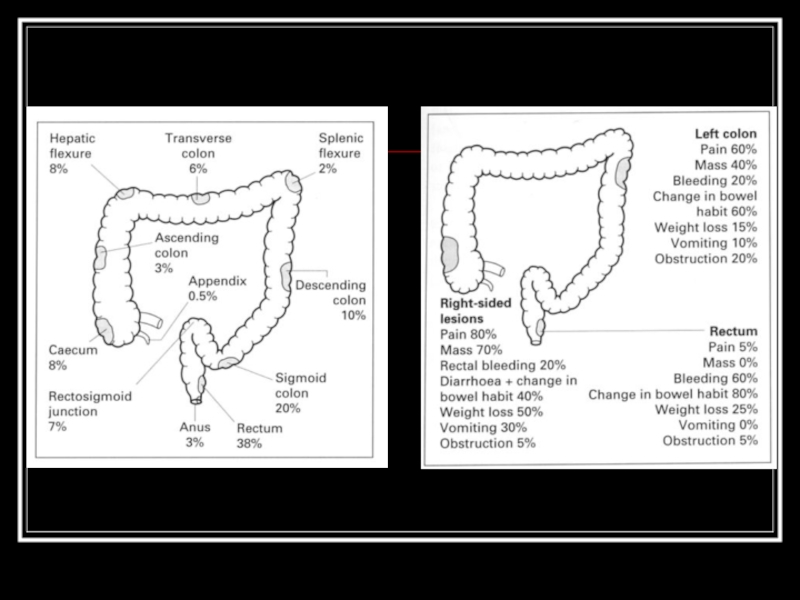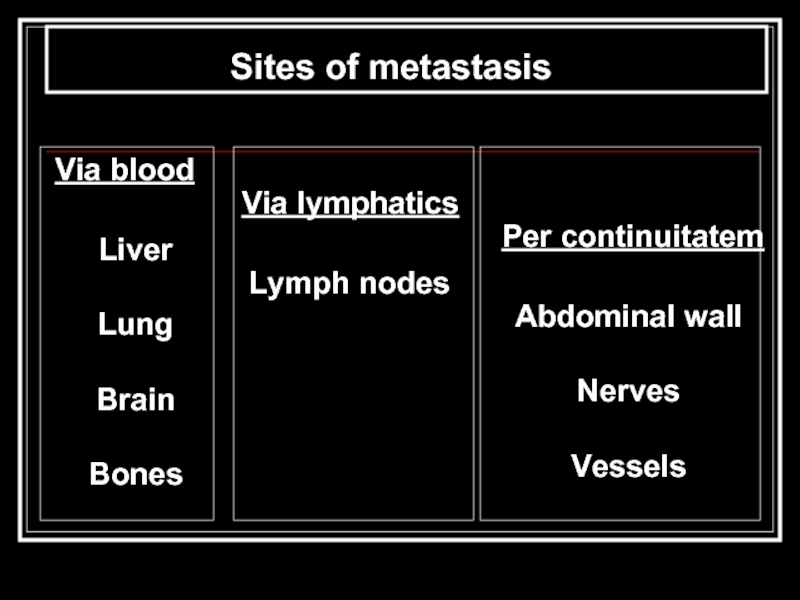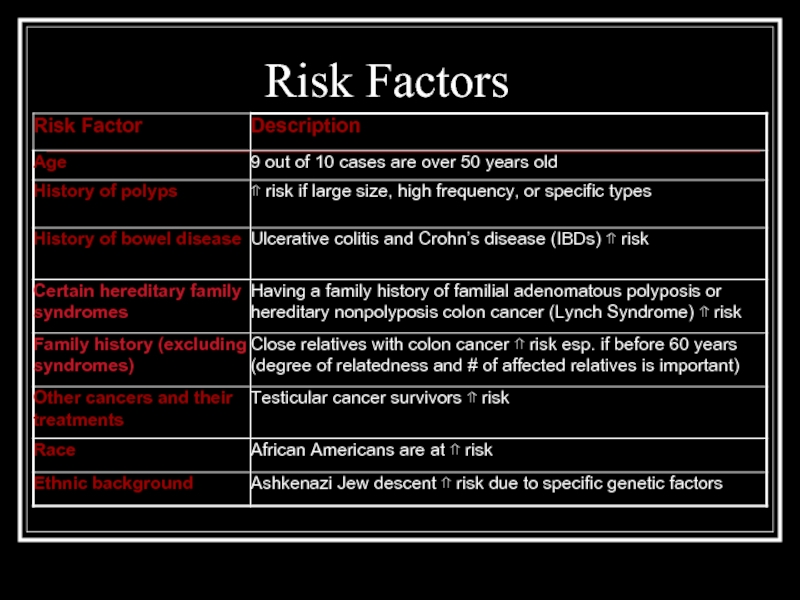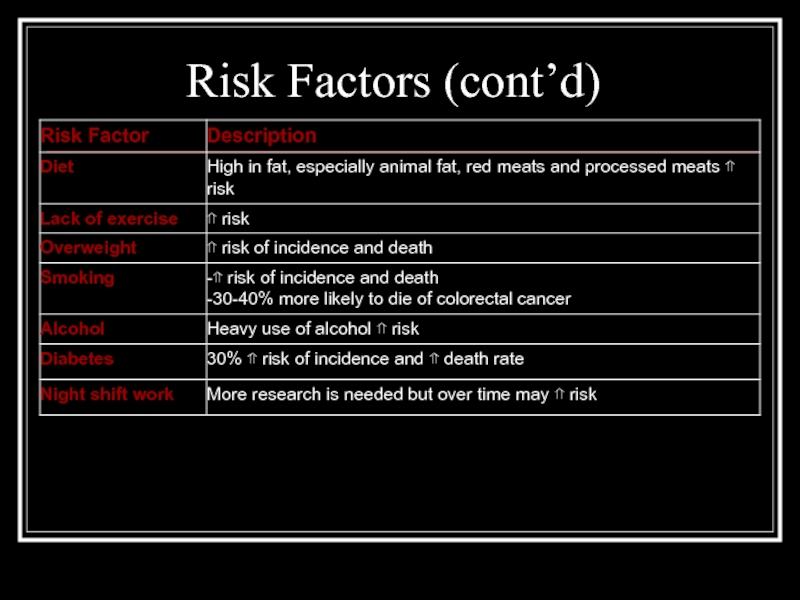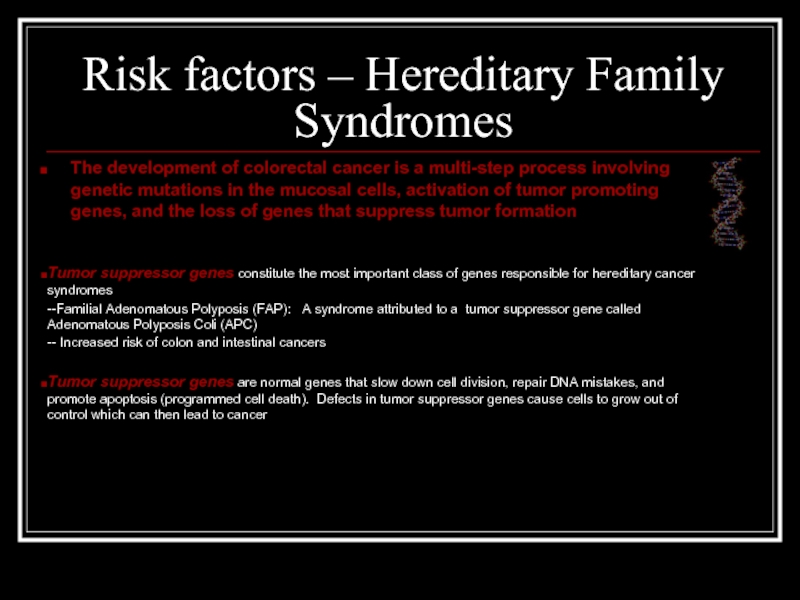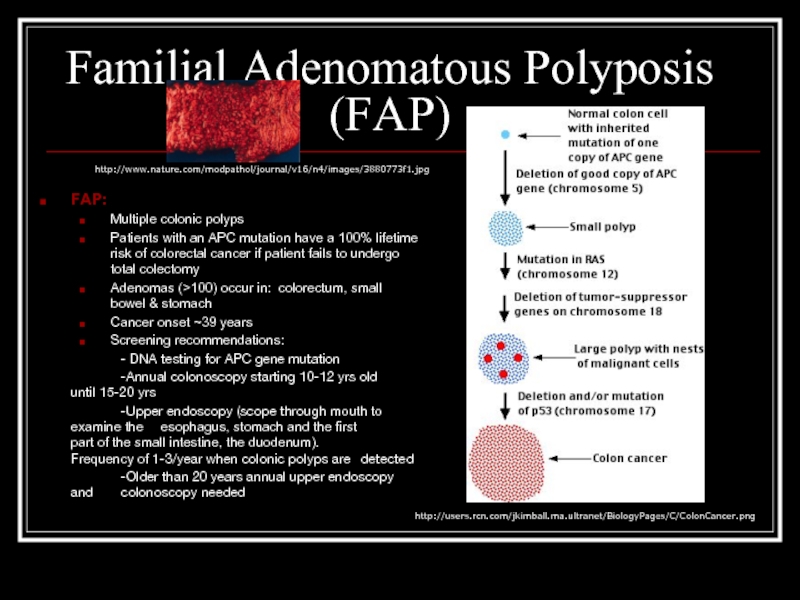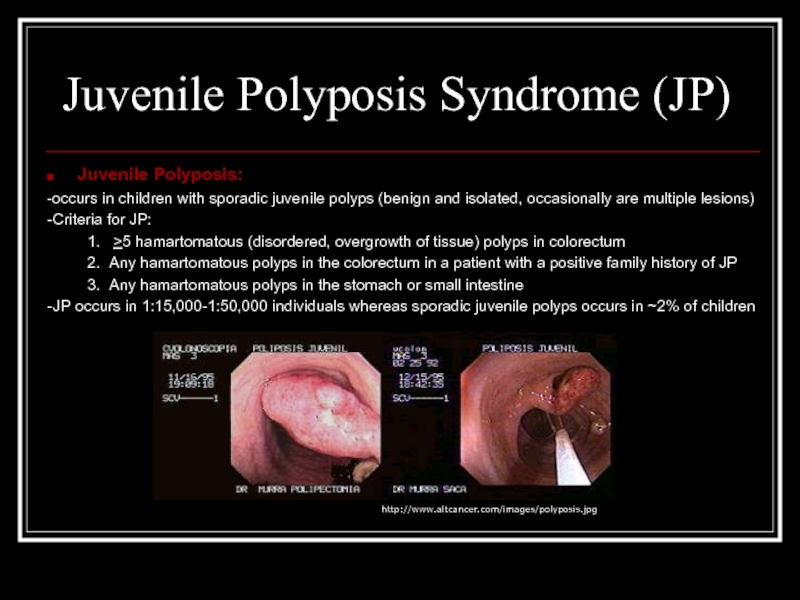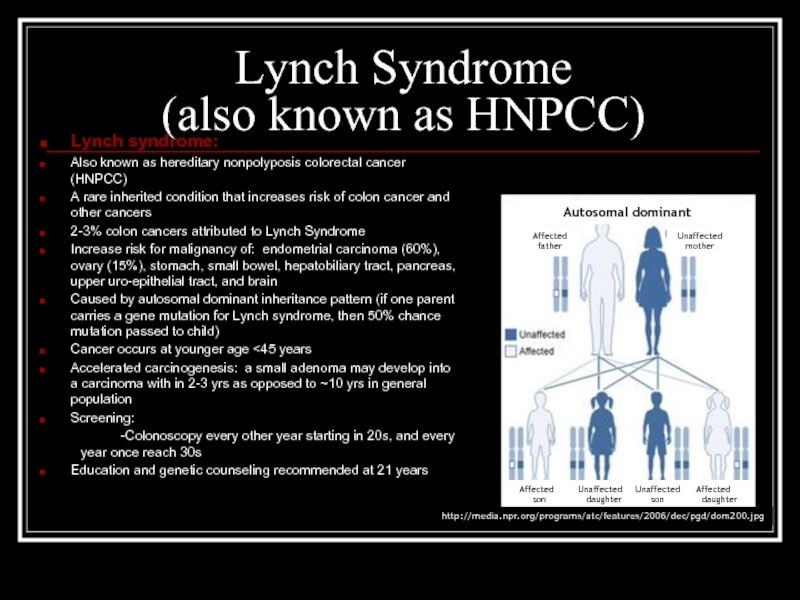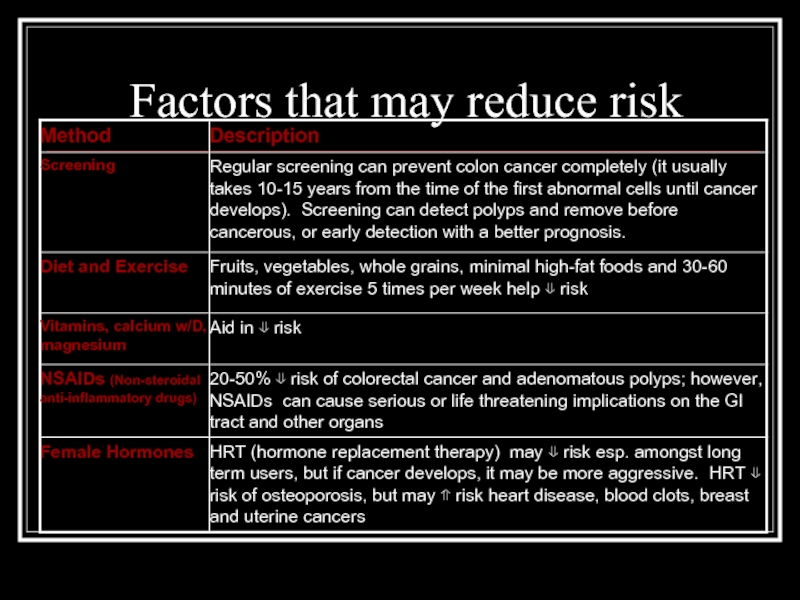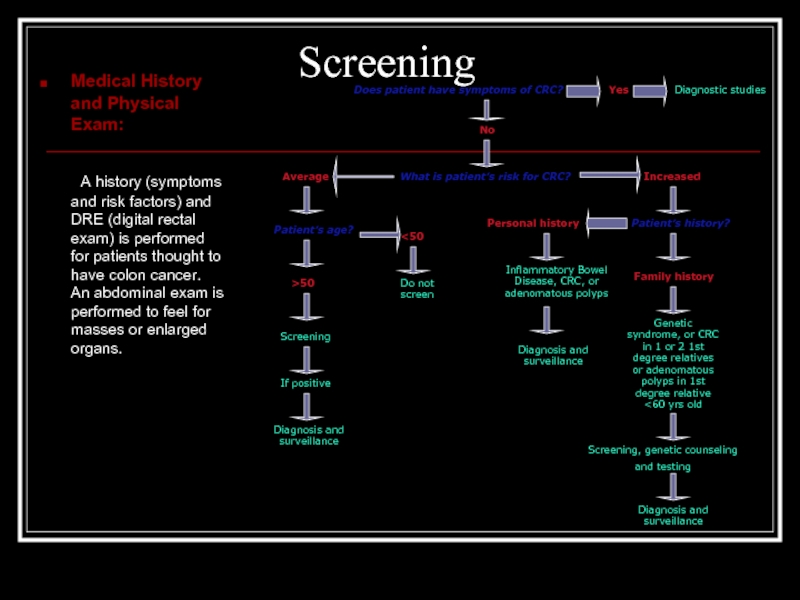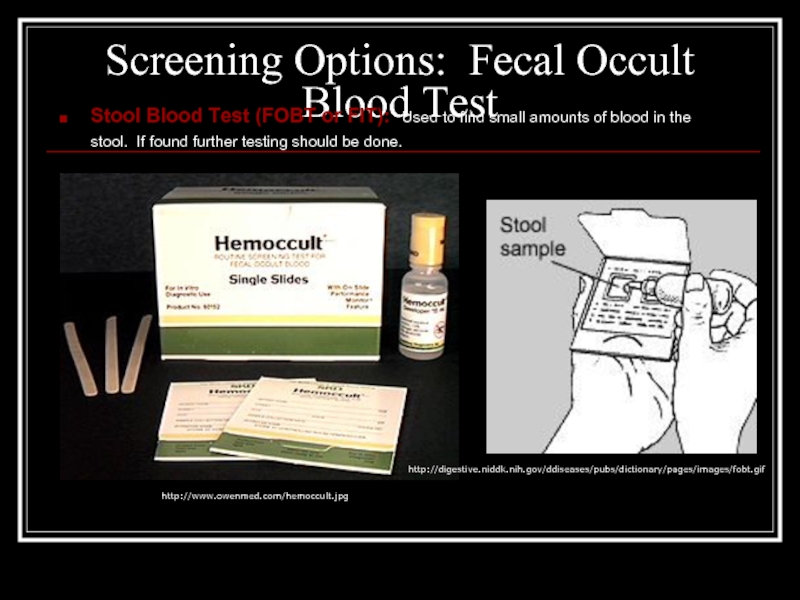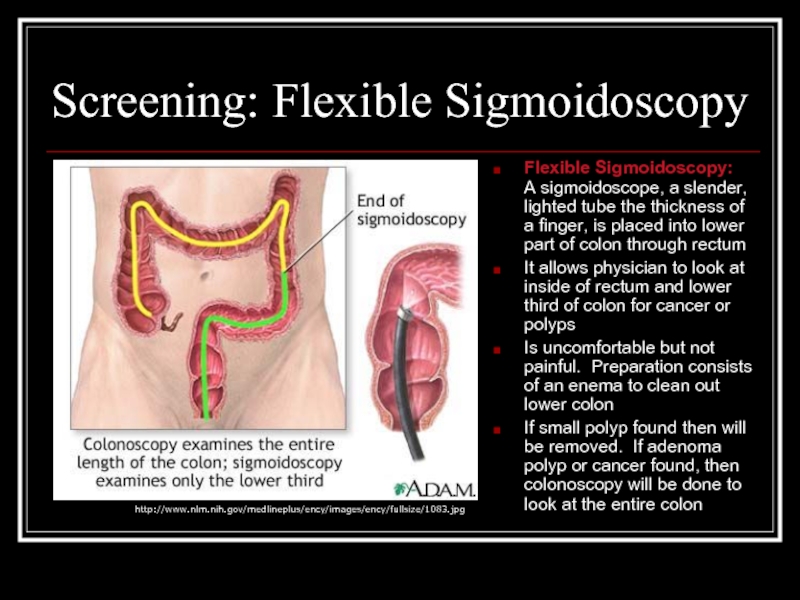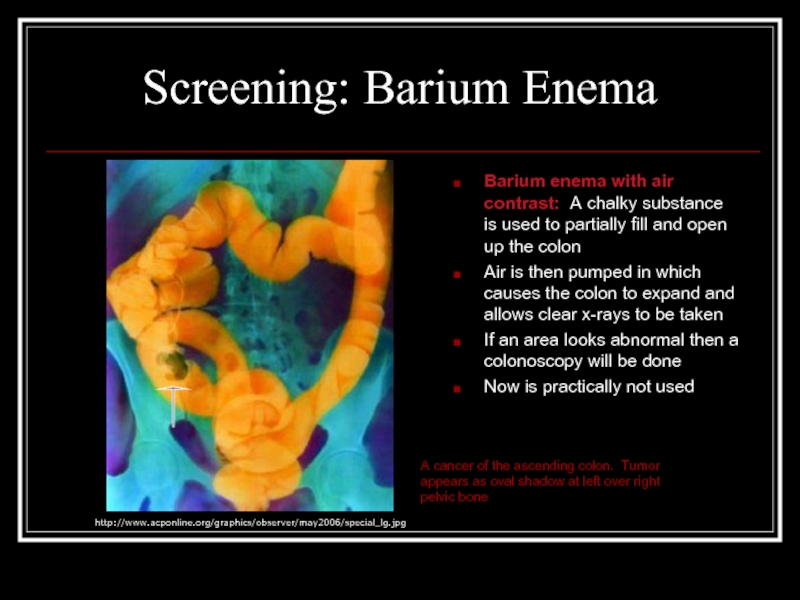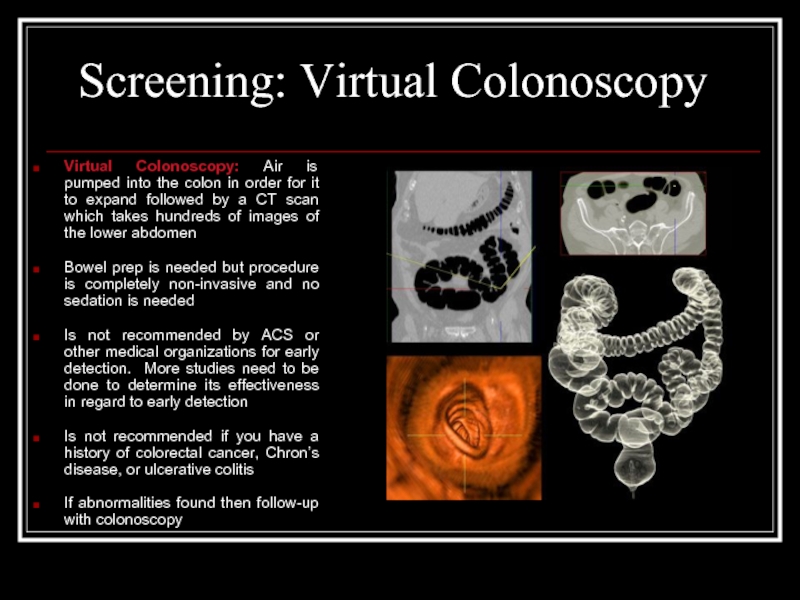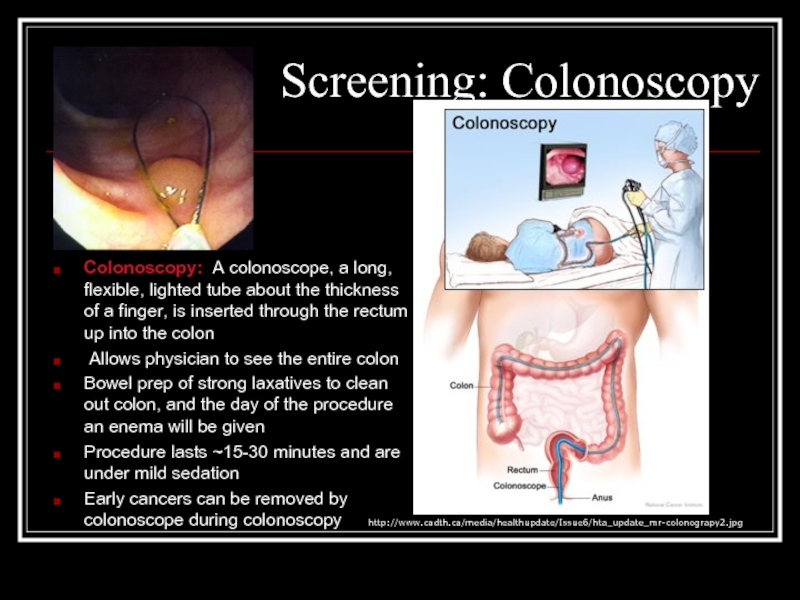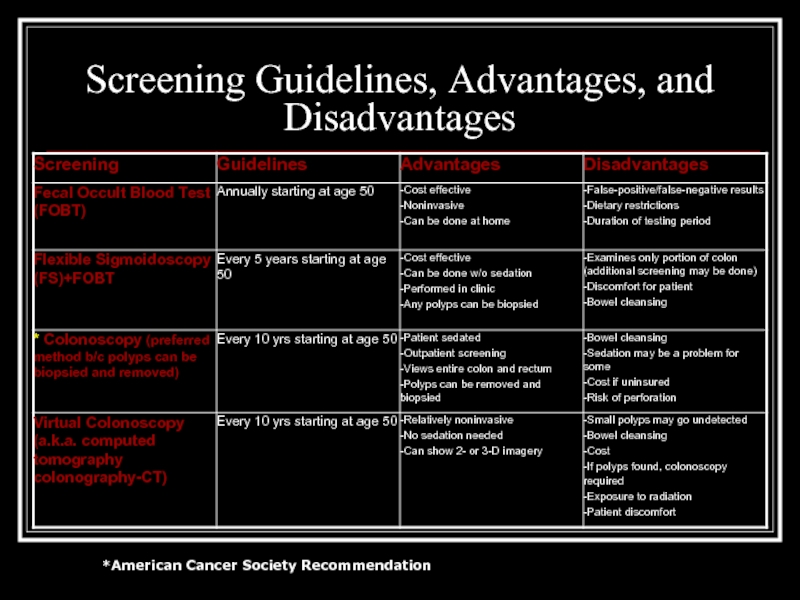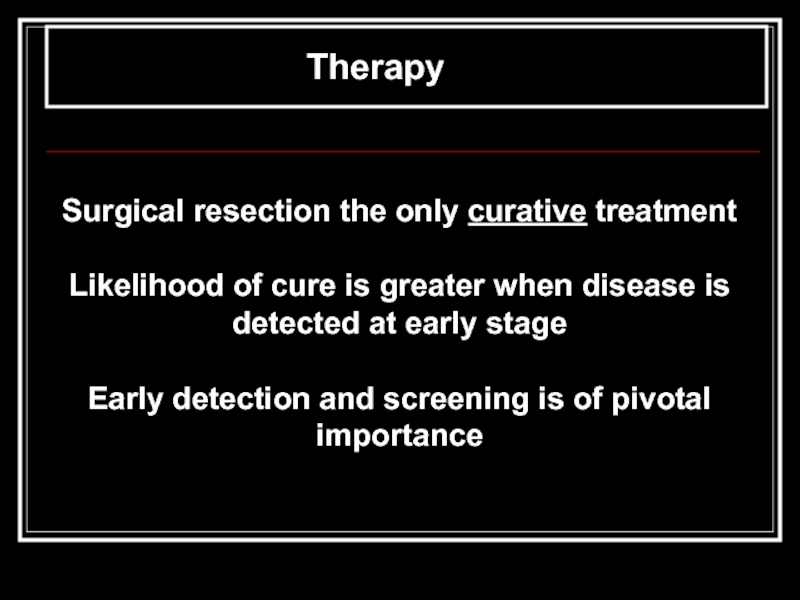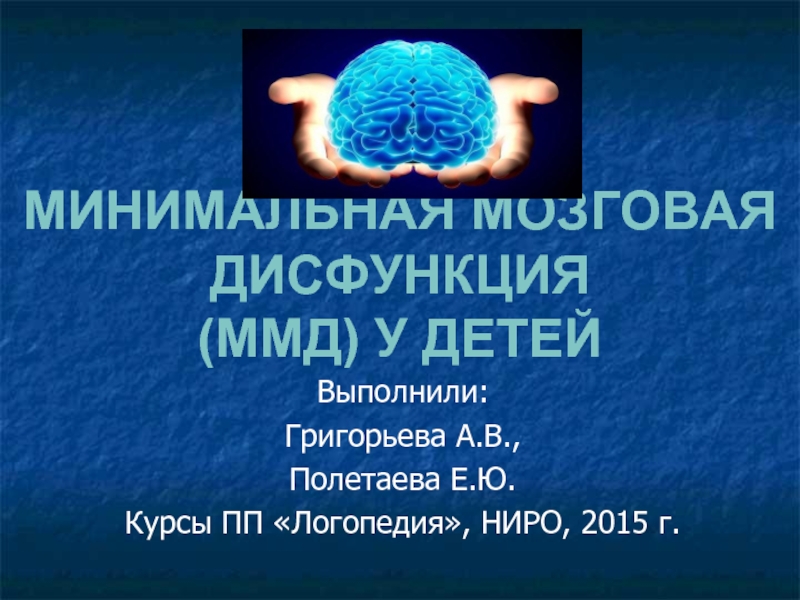- Главная
- Разное
- Дизайн
- Бизнес и предпринимательство
- Аналитика
- Образование
- Развлечения
- Красота и здоровье
- Финансы
- Государство
- Путешествия
- Спорт
- Недвижимость
- Армия
- Графика
- Культурология
- Еда и кулинария
- Лингвистика
- Английский язык
- Астрономия
- Алгебра
- Биология
- География
- Детские презентации
- Информатика
- История
- Литература
- Маркетинг
- Математика
- Медицина
- Менеджмент
- Музыка
- МХК
- Немецкий язык
- ОБЖ
- Обществознание
- Окружающий мир
- Педагогика
- Русский язык
- Технология
- Физика
- Философия
- Химия
- Шаблоны, картинки для презентаций
- Экология
- Экономика
- Юриспруденция
Colorectal Cancer презентация
Содержание
- 1. Colorectal Cancer
- 2. Top 10 Cancer Types and Colorectal Statistics
- 3. Anatomy of the Colon and Rectum The
- 4. Colorectal Cancer Development Colorectal cancer refers to
- 5. TNM system Primary tumor (T)
- 6. T Staging-American Joint Committee on Cancer system
- 7. N and M Staging-American Joint Committee on
- 8. Staging-American Joint Committee on Cancer system (AJCC/TNM)
- 9. Staging of colorectal cancer
- 10. Staging of colorectal cancer
- 11. 90 % cancers arise from polyps polyp – cancer 8 – 10 yrs
- 12. Symptoms of Colorectal Cancer Early colon cancer
- 14. Sites of metastasis Liver Lung
- 15. Risk Factors
- 16. Risk Factors (cont’d)
- 17. Risk factors – Hereditary Family Syndromes The
- 18. Familial Adenomatous Polyposis (FAP) FAP: Multiple
- 19. Juvenile Polyposis Syndrome (JP) Juvenile Polyposis: -occurs
- 20. Lynch Syndrome (also known as HNPCC)
- 21. Factors that may reduce risk
- 22. Screening Medical History and Physical Exam:
- 23. Screening Options: Fecal Occult Blood Test Stool
- 24. Screening: Flexible Sigmoidoscopy Flexible Sigmoidoscopy: A sigmoidoscope,
- 25. Screening: Barium Enema Barium enema with air
- 26. Screening: Virtual Colonoscopy Virtual Colonoscopy: Air is
- 27. Screening: Colonoscopy Colonoscopy: A colonoscope, a long,
- 28. Screening Guidelines, Advantages, and Disadvantages *American Cancer Society Recommendation
- 29. Therapy Surgical resection the only curative
Слайд 2Top 10 Cancer Types and Colorectal Statistics in the US
The third
The number of deaths has ⇓ over the last 15 years due to better screening, earlier detection of polyps and cancer, improved treatment, and more effective options
Currently ~1 million survivors in US
5-yr survival rate with early detection >90% (occurs in ~39% cases)
If cancer metastasized 5-yr survival rate, <10%
C: 55,290 R: 23,840
C: 57,050 R: 17,580
C & R: 26, 000
C & R: 26, 180
Слайд 3Anatomy of the Colon and Rectum
The colon has four sections: ascending,
The colon absorbs water and nutrients from food and serves as a storage for waste.
Слайд 4Colorectal Cancer Development
Colorectal cancer refers to cancer originating in the colon
Colorectal cancer develops slowly over a period of years (~10-15 yrs)
Colorectal cancer begins as a polyp.
Слайд 6T Staging-American Joint Committee on Cancer system (AJCC/TNM)
T Categories: Describes the
Tis: Cancer is in its earliest stage, has not grown beyond mucosa. Also known as carcinoma in situ or intramucosal carcinoma
T1: Cancer has grown through mucosa and extends into submucosa
T2: Cancer extends into thick muscle layer
T3: Cancer has spread to subserosa but not to any nearby organs or tissues
T4: Cancer has spread completely through wall of the colon or rectum into nearby tissues or organs
http://www.nlm.nih.gov/medlineplus/ency/images/ency/fullsize/19218.jpg
Слайд 7N and M Staging-American Joint Committee on Cancer system (AJCC/TNM)
N categories:
N0: No lymph node involvement
N1: Cancer cells found in 1-3 regional lymph nodes
N2: Cancer cells found in 4 or more regional lymph nodes
M Categories: describes the absence or presence of distant metastasis (M)
M0: No distant spread
M1: Distant spread is present
Lymph nodes are small, bean shaped structures that form and store white blood cells to fight infection.
An iceball in a patient with a metastases from a colon cancer receiving cryosurgery treatment
http://www.livercancer.com/treatments/images/cryo.jpeg
http://www.ricancercouncil.org/img/hodgkins.gif
Слайд 8Staging-American Joint Committee on Cancer system (AJCC/TNM)
Staging is an indicator of
Stage grouping: From least advanced (stage 0) to most advanced (stage IV) stage of colorectal cancer
Слайд 12Symptoms of Colorectal Cancer
Early colon cancer usually presents with no symptoms.
Symptoms include:
-a change in bowel habits (diarrhea, constipation, or narrowing of the stool for more than a few days)
-a constant urgency of needing to have a bowel movement
-bleeding from the rectum or blood in the stool (the stool often looks normal)
-cramping or steady stomach pain
-weakness and fatigue or anemia
-unexplained weight loss
A polyp as seen during colonoscopy
Слайд 14Sites of metastasis
Liver
Lung
Brain
Bones
Via blood
Lymph nodes
Abdominal wall
Nerves
Vessels
Via lymphatics
Per continuitatem
Слайд 17Risk factors – Hereditary Family Syndromes
The development of colorectal cancer is
Tumor suppressor genes constitute the most important class of genes responsible for hereditary cancer syndromes
--Familial Adenomatous Polyposis (FAP): A syndrome attributed to a tumor suppressor gene called Adenomatous Polyposis Coli (APC)
-- Increased risk of colon and intestinal cancers
Tumor suppressor genes are normal genes that slow down cell division, repair DNA mistakes, and promote apoptosis (programmed cell death). Defects in tumor suppressor genes cause cells to grow out of control which can then lead to cancer
Слайд 18Familial Adenomatous Polyposis (FAP)
FAP:
Multiple colonic polyps
Patients with an APC mutation
Adenomas (>100) occur in: colorectum, small bowel & stomach
Cancer onset ~39 years
Screening recommendations:
- DNA testing for APC gene mutation
-Annual colonoscopy starting 10-12 yrs old until 15-20 yrs
-Upper endoscopy (scope through mouth to examine the esophagus, stomach and the first part of the small intestine, the duodenum). Frequency of 1-3/year when colonic polyps are detected
-Older than 20 years annual upper endoscopy and colonoscopy needed
http://users.rcn.com/jkimball.ma.ultranet/BiologyPages/C/ColonCancer.png
http://www.nature.com/modpathol/journal/v16/n4/images/3880773f1.jpg
Слайд 19Juvenile Polyposis Syndrome (JP)
Juvenile Polyposis:
-occurs in children with sporadic juvenile polyps
-Criteria for JP:
1. >5 hamartomatous (disordered, overgrowth of tissue) polyps in colorectum
2. Any hamartomatous polyps in the colorectum in a patient with a positive family history of JP
3. Any hamartomatous polyps in the stomach or small intestine
-JP occurs in 1:15,000-1:50,000 individuals whereas sporadic juvenile polyps occurs in ~2% of children
http://www.altcancer.com/images/polyposis.jpg
Слайд 20Lynch Syndrome
(also known as HNPCC)
Lynch syndrome:
Also known as
A rare inherited condition that increases risk of colon cancer and other cancers
2-3% colon cancers attributed to Lynch Syndrome
Increase risk for malignancy of: endometrial carcinoma (60%), ovary (15%), stomach, small bowel, hepatobiliary tract, pancreas, upper uro-epithelial tract, and brain
Caused by autosomal dominant inheritance pattern (if one parent carries a gene mutation for Lynch syndrome, then 50% chance mutation passed to child)
Cancer occurs at younger age <45 years
Accelerated carcinogenesis: a small adenoma may develop into a carcinoma with in 2-3 yrs as opposed to ~10 yrs in general population
Screening:
-Colonoscopy every other year starting in 20s, and every year once reach 30s
Education and genetic counseling recommended at 21 years
Autosomal dominant
Affected father
Unaffected mother
Affected Unaffected Unaffected Affected
son daughter son daughter
http://media.npr.org/programs/atc/features/2006/dec/pgd/dom200.jpg
Слайд 22Screening
Medical History and Physical Exam:
A history (symptoms and risk factors)
Does patient have symptoms of CRC? Yes Diagnostic studies
What is patient’s risk for CRC?
Patient’s age?
Average
>50
Do not screen
If positive
Screening
Diagnosis and surveillance
Diagnosis and surveillance
Diagnosis and surveillance
Screening, genetic counseling
and testing
Increased
Patient’s history?
Personal history
Family history
Inflammatory Bowel Disease, CRC, or adenomatous polyps
Genetic syndrome, or CRC in 1 or 2 1st degree relatives or adenomatous polyps in 1st degree relative <60 yrs old
No
<50
Слайд 23Screening Options: Fecal Occult Blood Test
Stool Blood Test (FOBT or FIT):
http://digestive.niddk.nih.gov/ddiseases/pubs/dictionary/pages/images/fobt.gif
http://www.owenmed.com/hemoccult.jpg
Слайд 24Screening: Flexible Sigmoidoscopy
Flexible Sigmoidoscopy: A sigmoidoscope, a slender, lighted tube the
It allows physician to look at inside of rectum and lower third of colon for cancer or polyps
Is uncomfortable but not painful. Preparation consists of an enema to clean out lower colon
If small polyp found then will be removed. If adenoma polyp or cancer found, then colonoscopy will be done to look at the entire colon
http://www.nlm.nih.gov/medlineplus/ency/images/ency/fullsize/1083.jpg
Слайд 25Screening: Barium Enema
Barium enema with air contrast: A chalky substance is
Air is then pumped in which causes the colon to expand and allows clear x-rays to be taken
If an area looks abnormal then a colonoscopy will be done
Now is practically not used
A cancer of the ascending colon. Tumor appears as oval shadow at left over right pelvic bone
http://www.acponline.org/graphics/observer/may2006/special_lg.jpg
Слайд 26Screening: Virtual Colonoscopy
Virtual Colonoscopy: Air is pumped into the colon in
Bowel prep is needed but procedure is completely non-invasive and no sedation is needed
Is not recommended by ACS or other medical organizations for early detection. More studies need to be done to determine its effectiveness in regard to early detection
Is not recommended if you have a history of colorectal cancer, Chron’s disease, or ulcerative colitis
If abnormalities found then follow-up with colonoscopy
Слайд 27Screening: Colonoscopy
Colonoscopy: A colonoscope, a long, flexible, lighted tube about the
Allows physician to see the entire colon
Bowel prep of strong laxatives to clean out colon, and the day of the procedure an enema will be given
Procedure lasts ~15-30 minutes and are under mild sedation
Early cancers can be removed by colonoscope during colonoscopy
http://www.cadth.ca/media/healthupdate/Issue6/hta_update_mr-colonograpy2.jpg
Слайд 29Therapy
Surgical resection the only curative treatment
Likelihood of cure is greater when
detected at early stage
Early detection and screening is of pivotal
importance
